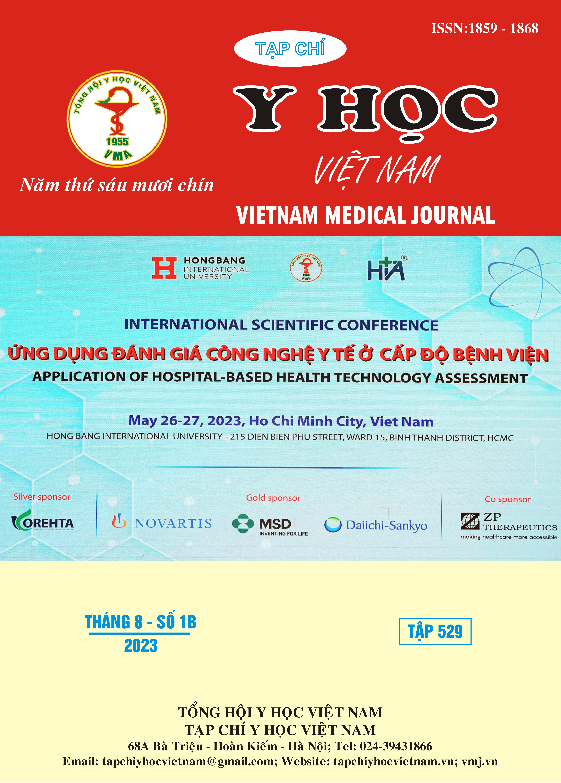TREATMENT RESULTS FOR SURGICAL CORRECTION OF EARLY ONSET SCOLIOSIS WITH DUAL GROWING ROD TECHNIQUE
Main Article Content
Abstract
Background: Growing rod is currently the gold standard treatment for early onset scoliosis. This study was conducted to evaluate outcomes of surgical treatments for early onset scoliosis by dual growing rods technique. Method: A longtitudinal study were conducted from January 2014 to June 2021. Clinical signs and symptoms, as well as imaging and laboratory parameters were studied extensively from the time of surgery till last follow-ups for all patients. Results: From January 2014 to June 2021, 22 patients (13 boys, 9 girls) with EOS were surgically corrected with dual growing rods, with the mean age of 6.3 ± 2.1 years. The most common signs presented were rib cage humps, and shoulder imbalance. The patients had their rods lengthened 2.3 ± 1.2 times (range 1-5 times). Cobb angles measured in the first and last follow ups were 28.36° and 34.05°, respectively (p value < 0,001, correction rate 62.34%). The improvement rate of thoracic kyposis was 68% perioperatively (p<0,001). The length of T1-S1 increased with statistical significance, from 28.7 cm preoperatively to 33.6 cm postoperatively (p value < 0,001). In seven patients presented with preoperative sagittal imbalance, five of them have gained normal sagital balance post surgery. Three patients had to go through another total rod correction afterwards. One patient did not require rod removal and total correction but was continously monitored. The main complications post-treatment were hook pullout (9.1%), followed by screw pullout, infection, and postsurgical haematoma. Conclusion: Currently, dual growing rod technique is still the optimal choice for treatment for early onset scoliosis. Appropriate consideration when determining hooks and screw placements, as well as meticulous rod contouring will help increase the correction rate and avoid complications
Article Details
Keywords
early onset scoliosis, growing rod, spinal balance, infantile, growing spine, scoliosis
References
2. B. A. Akbarnia và các cộng sự. (2008), "Dual growing rod technique followed for three to eleven years until final fusion: the effect of frequency of lengthening", Spine (Phila Pa 1976). 33(9), tr. 984-90.
3. B. A. Akbarnia và các cộng sự. (2005), "Dual growing rod technique for the treatment of progressive early-onset scoliosis: a multicenter study", Spine (Phila Pa 1976). 30(17 Suppl), tr. S46-57.
4. B. A. Akbarnia và các cộng sự. (2005), "Dual growing rod technique for the treatment of progressive early-onset scoliosis: a multicenter study.", Spine (Phila Pa 1976). 30(S55).
5. S. Bess và các cộng sự. (2010), "Complications of growing-rod treatment for early-onset scoliosis: analysis of one hundred and forty patients", J Bone Joint Surg Am. 92(15), tr. 2533-43.
6. C. Bouthors và các cộng sự. (2020), "Outcomes of growing rods in a series of early-onset scoliosis patients with neurofibromatosis type 1", J Neurosurg Spine, tr. 1-8.
7. A. M.D. Dimeglio (1993), "Growth of the Spine Before Age 5 Years", Journal of Pediatric Orthopaedics B: Volume 1 - Issue 2 - p 102-107.
8. C. K. Hardesty và các cộng sự. (2018), "Early-Onset Scoliosis: Updated Treatment Techniques and Results", Spine Deform. 6(4), tr. 467-472.
9. I. J. Helenius và các cộng sự. (2018), "Outcomes of growing rod surgery for severe compared with moderate early-onset scoliosis: a matched comparative study", Bone Joint J. 100-B(6), tr. 772-779.
10. N. Kabirian và các cộng sự. (2014), "Deep Surgical Site Infection Following 2344 Growing-Rod Procedures for Early-Onset Scoliosis: Risk Factors and Clinical Consequences", J Bone Joint Surg Am. 96(15), tr. e128.


